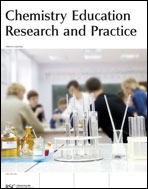Using chemistry simulations: attention capture, selective amnesia and inattentional blindness
Abstract
Twenty-one convenience sample student volunteers aged between 14-15 years worked in pairs (and one group of three) with two randomly allocated high quality conceptual (molecular level) and operational (mimicking wet labs) simulations. The volunteers were told they had five minutes to play, repeat, review, restart or stop the simulation, which in most cases lasted less than a minute. The volunteers were digitally video recorded as they worked in pairs. A semi-structured retrospective interview was conducted a few minutes later using the digital record depicting their behaviour and actions as a prompt. Participants were asked to explain what drove and determined their actions. The data sets show how attention capture, selective amnesia and inattentional blindness played a role in determining whether interaction was fruitful. The findings suggest that while some instructions may go through attention focus they may become 'unseen' or forgotten (selective amnesia) and other instructions may fall victim to inattentional blindness when cues provided by designers are missed. In addition, if initially two prompts (which may be a hint, or message or icon or symbol) appear together before one prompt disappears, then the remaining prompt gains precedence and, if interpreted inaccurately, may generate a false understanding.

 Please wait while we load your content...
Please wait while we load your content...